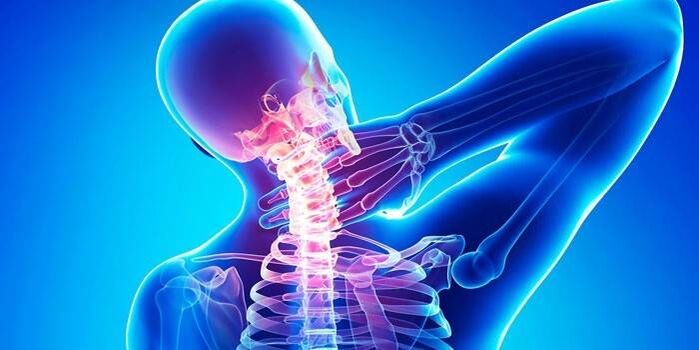Other names for this disease are degenerative wounds that damage the spine, affect the body of the vertebra, ligaments and together, intervertebral discs.It is common -often diagnosed in men and women, as a rule, develops after 30 years.According to statistics, from 50 to 80% of the population suffers from the disease.

Symptom classification for cervical osteochondrosis
The development of the disease sometimes occurs earlier than 30-35 years old, so signs of disease can occur even in adolescence.Signs of cervical osteochondrosis are discussed in detail below, the disease is a real problem with the modern world.Inactivity, staying in front of a computer that negatively affects one's health, well -being.All symptoms of cervical osteochondrosis are associated with damage in the operation of several systems:
- In the case of advanced, there are signs of redness, spinal cord integrity in the spinal cord.
- The pathological process can affect the peripheral nervous system.The root of the spinal core located next to the focus of the bone tissue is exposed to negative effects.
- In some cases, the vertebral artery is pinned.These blood vessels provide nutrients, oxygen to brain cells.Violation of this process leads to a sharp decline in human well -being.
Sore

It is known that one of the first signs of the development of the disease is pain in the cervical region.At first it passed quickly, periodically, but then went into a chronic form.The main place of localization of pain is:
- Occipital muscles (enhanced when neck, head tilt);
- shoulder area;
- neck.
It can hurt differently depending on the location of the lesion, unpleasant sensations can be acute, shooting, periodically, beching and constant.Over time, head movements are difficult, associated with neck muscle tension.If the artery is pinched, the cervical migraine is sometimes observed (with the weakness of blood supply, the lack of oxygen appears to have a headache).
Nausea
In some cases, the blood vessels of the blood circulatory system are squeezed, which ensures the flow of oxygen, nutrients to the human brain, inner ear.Because of this, nausea in osteochondrosis occurs.These symptoms are accompanied, as a rule, by loss of appetite, which causes weight loss, lack of nutrients.In later stages, the disease can trigger vomiting while turning heads, walking or tilting.This is due to the lack of blood flow to the middle ear, where the balance center is located.
Symptoms of cervical osteochondrosis neurological

Some manifestations of the disease cannot be associated with the characteristics of the characteristics.You should know what symptoms with cervical osteochondrosis cannot be ignored, for example, lack of air.With damage to this department, the diaphragm nerve irritation syndrome can develop.Patients have difficulty breathing, there is a lack of oxygen, which causes shortness of breath and even severe drowning.
This pathological manifestation is often accompanied by snoring, it is enhanced, if we take an uncomfortable position during sleep.This leads to the fact that one does not rest at night, waking up with general malaise, weakness, tiredness and breaking.In the absence of treatment, this condition can cause memory deterioration, decrease in concentration and irreversible changes in the brain tissue.
Signs -to vestibular
Another direction, how the cervical area osteochondrosis is shown - vestibular signs.The supply of the brain with all the necessary nutrients occurs through the vertebral artery.If the cervical osteochondrosis develops, where the ear work is interrupted, the patient has noise in his ears and rings.In certain cases, infringement or decline in hearing is added to these symptoms.
Bump in the throat
In some cases, the disease is indicated by only one symptom - it is difficult to swallow.It seems that lumps are formed in the throat with cervical spinal osteochondrosis, pain, itching, dryness, and swallowing difficult.This manifestation is associated with a violation of the flow of neurovascular stems derived from the spinal cord.Lumps in the throat are not specific symptoms of osteochondrosis, they may indicate tumors or inflammation.When this sign appears, you should definitely consult your doctor.
Sign of visual osteochondrosis of the cervical area
Symptoms of cervical spinal osteochondrosis can vary, but the visual decrease of visual disorders.The supply of visual analysts occurs through carotid and vertebrate.If blood circulation reduction occurs due to the last compression, the decline in vision begins, which does not improve when wearing the eyes.Cervical osteochondrosis - Symptoms:

- reduced pressure;
- "Floating", blinking eyes;
- arterial atherosclerosis in the brain;
- Violations focus on subjects;
- The lid, the fog in front of my eyes.
The characteristics of the decrease in vision are caused by pinching by the vertebral vessels, blood circulation disorders, will be a lack of improvement when wearing glasses, doing special exercises.Only timely treatment of underlying disease (before irreversible tissue lesions) will help change the condition.
The signs of the artery
The spine plays an important role in the human body, so any disease affects many systems.There are signs of cervical osteochondrosis arteries, which indicate the disease.This includes a sudden loss of consciousness.These are the most unpleasant and dangerous symptoms that exist in the disease.This is due to blood circulation disorders, when the blood temporarily stops flowing through the artery of the brain.
Significant artery cramps occur due to the reaction of the defective bone process for nerve end irritation.If your contacts have osteochondrosis from the cervical region and he has lost consciousness, he must be placed, lift his feet on a small hill to increase blood flow from the limbs and increase your brain intake.After that, people, as a rule, quickly come to their senses.
Blood pressure instability is another symptom of the disease from this group.Doctors can diagnose indicators if blood supply is interrupted.This is not a specific symptom of osteochondrosis, but it is in line with the overview of the disease.Blood pressure can decrease or increase.One feels deteriorating in this situation, so he or she needs to ensure peace.
Dizzy
It was previously illustrated that with this disease, sometimes there is a loss of consciousness.This occurs in cases when blood flow to the brain is very difficult.Often, patients feel dizzy for cervical osteochondrosis.These are frequent symptoms that accompany all patients with the disease.This phenomenon has a spontaneous manifestation.The cause of this condition is a reduction in the amount of oxygen to enter the inner ear.It is located in the human brain, responsible for a sense of balance.Dizziness occurs at:
- rotate head, neck;
- If you arrive -then get out of bed.
Temperature for osteochondrosis

In some cases, the pathological process is spread between the structure of the spinal cervical segment.This occurs when the disc increases, stenosis of the channel.The temperature for osteochondrosis is the body's reaction to pathological data.The same reaction is possible with vertebral artery syndrome.This is a frequent phenomenon for osteochondrosis in the last stage of disease progression.Therefore, increasing temperature refers to the symptoms of non -specific disease.
This sign will not be present, the body thermoregulation may be normal.If you have persistent pain in the nape, shoulders, neck, and when turning or tilting your head, severity, you should contact a specialist, undergo examination.The lack of treatment should lead to the fact that the condition will decline, the level of comfort of life decreases.























